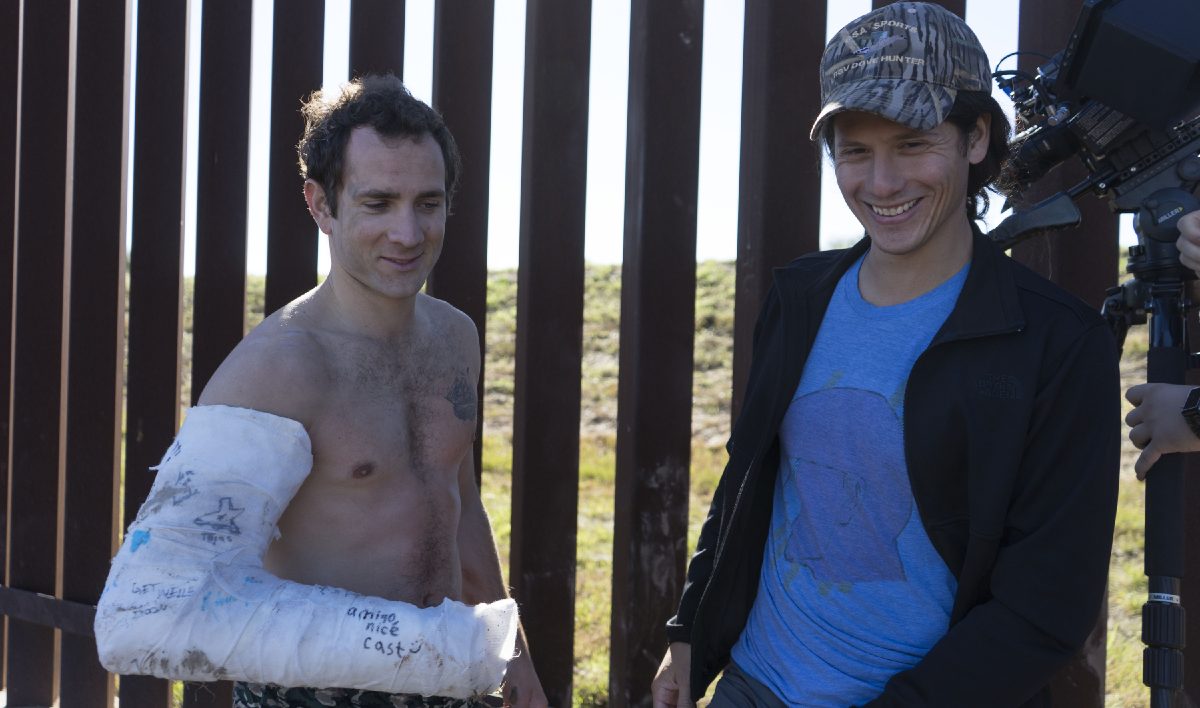HARLINGEN — David Blue Garcia remembers growing up surrounded by corn fields and around farmland near La Feria.
Having no close neighbors might have opened up his imagination, he says
Today, the Harlingen native is an award-winning film director breaking out in the industry with his movie “Tejano.”
The movie is about Javi who is played by McAllen native Patrick Mackie, a blue-eyed Tejano working with his grandfather played by Hector Uribe, who is a former state senator, on their chicken farm in South Texas, just a few miles from the Mexican border.
In the movie, the main character frequently takes trips to Matamoros to fill prescriptions at a pharmacy where his girlfriend Lorena works while he’s saving up cash to bring her into the United States.
The couple’s plan is to start a new life in San Antonio, but the story takes a wild turn when Javi finds himself plunged into the deep end of drug trafficking for Lorena’s sleazy brother Adelio and his ruthless boss Gloria.
Early start
Garcia was born and raised in Harlingen but he moved to Austin to attend the University of Texas in 2003.
For him filmmaking began as early as middle school.
“I fell in love with making movies, holding the camera and making short films with my friends,” Garcia said.
He attended Harlingen High School where he continued to pursue what used to be a hobby, until he eventually attended film school.
“My passion for filmmaking has been going on for over 20 years. The reason I got into filmmaking was mainly because I realized every other career that interested me stemmed from a movie,” he said.
Garcia said as soon as he picked up his father’s VHS camera he discovered making movies of his own gave him joy by telling a story through editing.
“I made silly skateboarding films to a parody of Jaws called Paws and it was about the cats that lived under our high school,” he said.
The start of “Tejano”
The scenery of his breakout movie is very similar to where Garcia grew up. Though this was not intentional, he said he listened to stories from South Texans and combined it all to create the story with screenwriter Kyle Bogart.
“I first came up with the idea in 2010 and now it is 2020,” he said.
The movie, which was premiered in 2018, will be airing on HBO on Jan. 17 and will be available on HBO streaming apps.
“It has been a decade since the origin of the idea but not of working on it,” he said.
The screenplay was written in 2013 and the movie was shot in the Rio Grande Valley in 2015.
“It premiered at the Dallas International Film Festival, where it won the audience award, which is the audience’s favorite film,” he said.
He said the film has won around 20 awards at film festivals around the country.
The movie has been screened in Austin, Harlingen and other cities. Garcia said every screening has been sold out.
“This is my first movie as a director where I originated the story where I produced and directed,” Garcia said.
“I am not new to movies but this is my directorial debut. It is very difficult to make a film for anyone because there’s a lot of difficulties and those are enhanced when you don’t have a lot of money or budget,” he said.
“You have to get creative to accomplish things and use your actors to create solutions that otherwise would be solved with money,” Garcia said.
Luckily, Garcia was able to film on friends and family member’s property for free.
“I knew they would open their doors to me, the fields I remembered growing up in. It is very important in a low budget movie to get that help,” he said.
Rio Grande Valley Representation
For Garcia it was very important for actors to be from the Rio Grande Valley as well as bilingual.
According to him, being familiar with the area and the culture was primordial for the essence of the movie.
“I cast all actors from the Rio Grande Valley. They might not live there now but they all were born and raised in South Texas. They’ve got the language, the culture and a lot of that comes out in the film,” Garcia said.
“People will recognize the language. The characters speak a mix of English and Spanish, which is common among many families in the Valley,” he said.
As opposed to his actors, Garcia is not bilingual, though he comes from a multicultural background.
“There was a lot of racism in the 1950s and it was a bad thing to speak Spanish so my father chose not to teach us so we would not have that experience,” Garcia said.
His father is from Mexican descent and his mother is white.
“I always felt left out because I had family members and cousins who spoke it. I felt like an outsider but learned a little bit in college,” he said.
The landscape of the Rio Grande Valley is prominent in the cinematography of the film, something Garcia said he wanted to showcase.
“I believe in regional filmmaking and movies are a great way of shedding light on a micro culture. I think stories that are told in South Texas pay attention to the intricacies of the culture and the frontier of the borderlands,” Garcia said.
“It is a different culture from the rest of Texas and even a different one from Mexico. Like its own transitional culture and it deserves to be illuminated on screen. The country is obsessed with the Rio Grande Valley but I feel like the culture is not quite understood. As South Texans it is good we write about it and showcase it so that people might understand it more,” he said.











